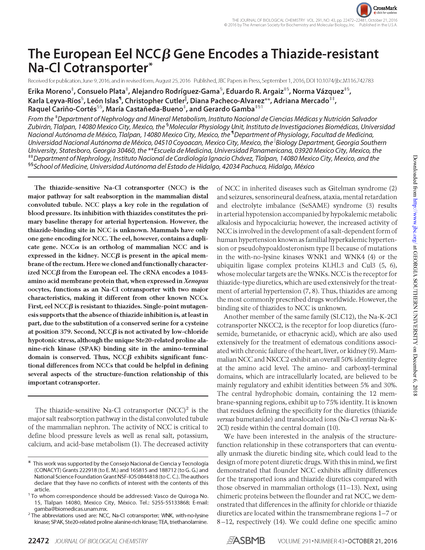
The thiazide-sensitive Na-Cl cotransporter (NCC) is the major pathway for salt reabsorption in the mammalian distal convoluted tubule. NCC plays a key role in the regulation of blood pressure. Its inhibition with thiazides constitutes the primary baseline therapy for arterial hypertension. However, the thiazide-binding site in NCC is unknown. Mammals have only one gene encoding for NCC. The eel, however, contains a duplicate gene. NCCα is an ortholog of mammalian NCC and is expressed in the kidney. NCCβ is present in the apical membrane of the rectum. Here we cloned and functionally characterized NCCβ from the European eel. The cRNA encodes a 1043-amino acid membrane protein that, when expressed in Xenopus oocytes, functions as an Na-Cl cotransporter with two major characteristics, making it different from other known NCCs. First, eel NCCβ is resistant to thiazides. Single-point mutagenesis supports that the absence of thiazide inhibition is, at least in part, due to the substitution of a conserved serine for a cysteine at position 379. Second, NCCβ is not activated by low-chloride hypotonic stress, although the unique Ste20-related proline alanine-rich kinase (SPAK) binding site in the amino-terminal domain is conserved. Thus, NCCβ exhibits significant functional differences from NCCs that could be helpful in defining several aspects of the structure-function relationship of this important cotransporter.
Copyright belongs to Elsevier. Information regarding the dissemination and usage of journal articles can be accessed through the following links.Â
Available at: http://works.bepress.com/christopher-cutler/20/

This research was originally published in the Journal of Biological Chemistry. Moreno, et al. The European Eel NCCβ Gene Encodes a Thiazide-Resistant Na-Cl Cotransporter. J. Biol. Chem. 2016; 291, 22472-22481. © 2016 by The American Society for Biochemistry and Molecular Biology, Inc.
Authors are allowed to post the final, edited PDF, created by ASBMB, to their own departmental/university websites following a twelve (12) month embargo.